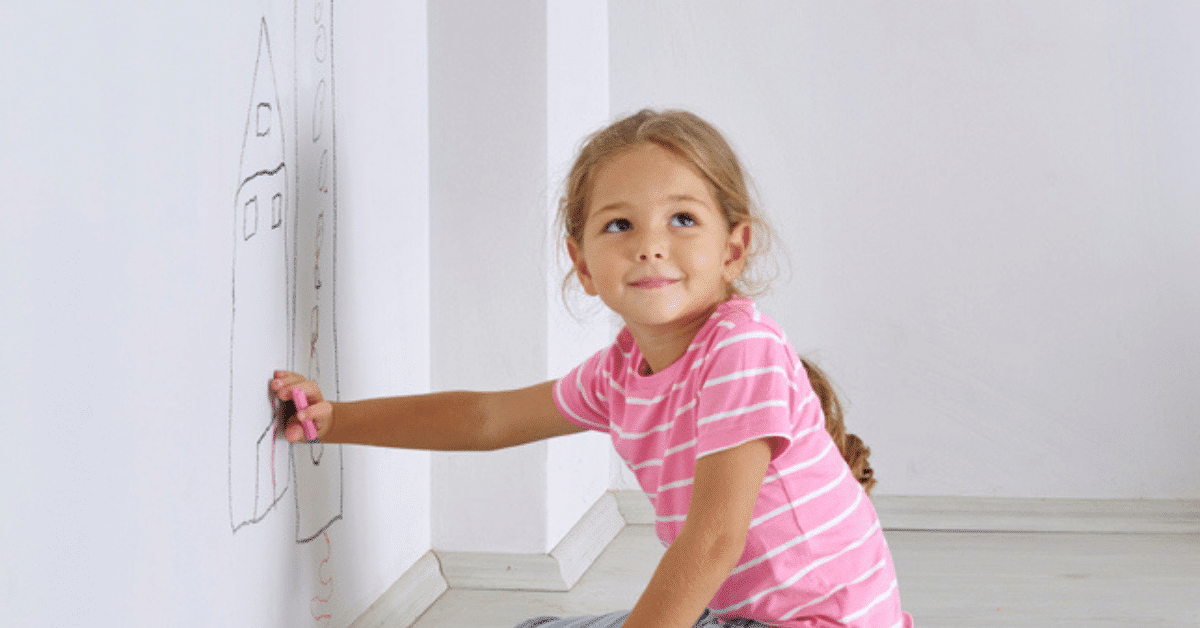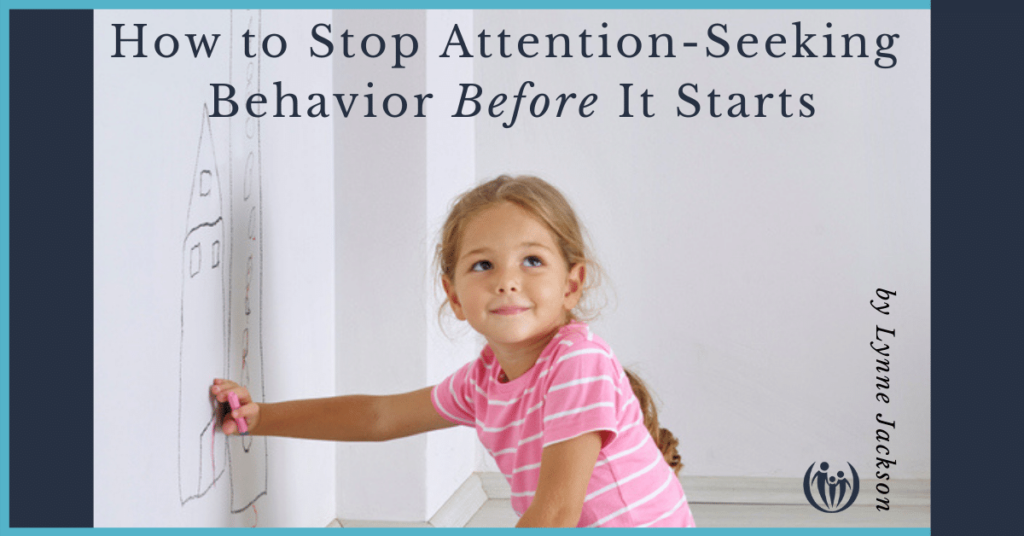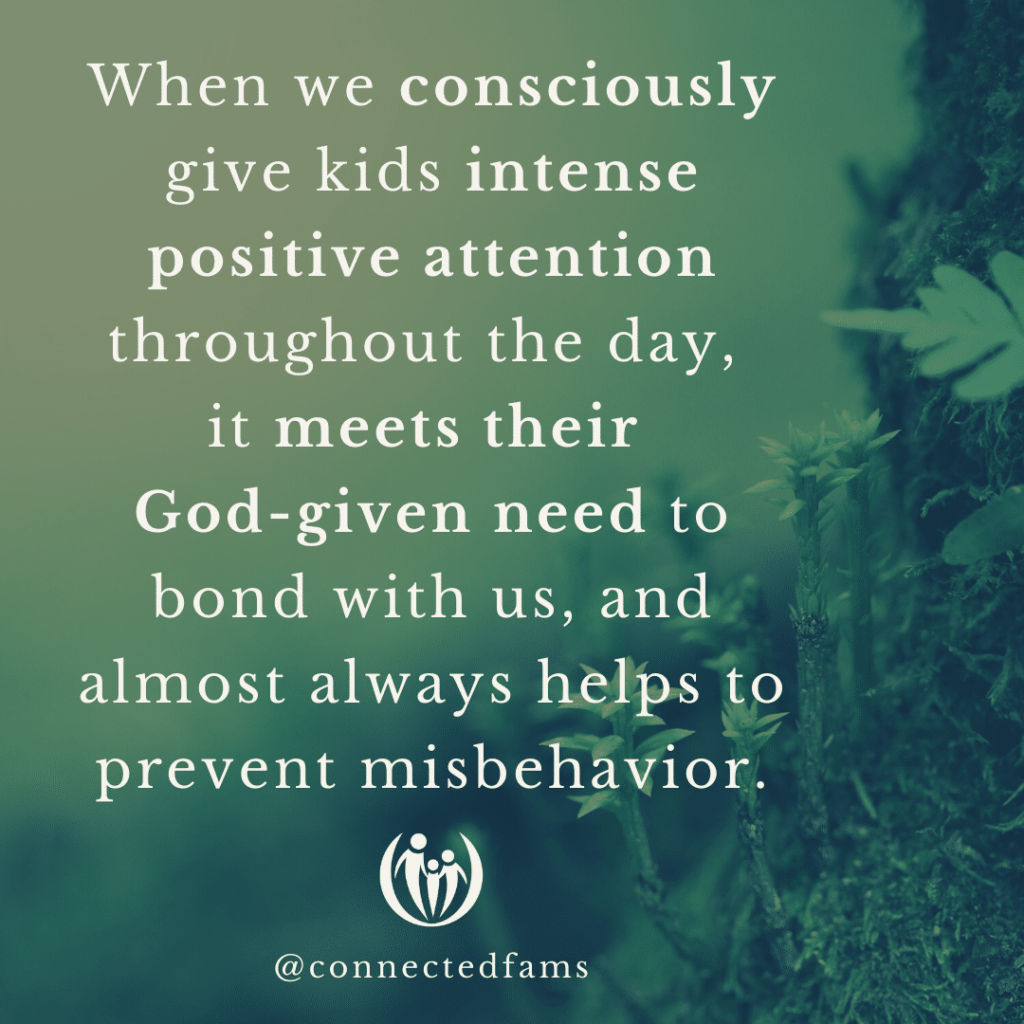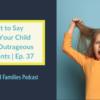
How to Stop Attention-Seeking Behavior Before It Starts

Some kids need a lot of attention. And they still want more. It can be pretty frustrating. Maybe you feel ready to do anything to stop your kids’ attention-seeking behavior.
In fact, sometimes it turns into an adversarial relationship. Have you ever said (or felt) any of these statements?
- “My child is determined to push my buttons.”
- “She just acts out to get attention.”
- “I get so tired of his misbehavior. I just don’t enjoy my son any more.”
Some common advice you may have heard: Ignore your child (even turning your back!), and the behavior will stop. A slightly more sophisticated version says to ignore the behavior. Unfortunately, when your child is misbehaving, it can be hard to distinguish between ignoring your child and ignoring their behavior.
But what if I said, after decades of parent coaching, the only healthy way to stop attention-seeking behavior is to prevent it? And the only way to prevent it? Give your child attention.
Notice your child. Give them attention. But not for misbehavior.
Of course, you probably don’t have hours and hours of time most days. But guess what? You can give your child the attention they need in 30 seconds or less. Because that is what’s realistic.
You can do this.
How attention-seeking behavior starts
Misbehaving kids are often discouraged and looking for a strong emotional response from their parents. They want to know they matter to their parents!
In fact, being noticed is a core emotional need.
But in the blur of family life, kids often get your energized response when they misbehave. “Carson James Smith! Stop that right now!” delivered with intense eye contact and furrowed brow.
Ah, zing. Reward. Connection made. Cycle reinforced.
Carson just got lots of attention. For misbehavior. Unfortunately, it also strengthened his identity as a pain-in-the-neck, and he is even more likely to repeat the behavior. Soon.
Parents resent this repeated misbehavior and often connect even less with their child as a result. And their child misbehaves more to get more of this negative connection—because he needs a connection!
Change how you view attention seeking
Changing this pattern starts with realizing: My kids have a God-given need for my intense attention! It’s an important part of bonding. This is especially true of more challenging kids. They are looking for an “intensity match” to their big emotions.
There are better ways to meet that need than “fertilizing” kids’ misbehavior with strong negative attention. When we consciously give kids intense positive attention throughout the day, it meets their God-given need to bond with us, and almost always helps to prevent misbehavior.
3 strategies to help break attention-seeking patterns
Here is where stressed-out parents can feel stuck:
- “I feel like I’m too negative with my kids, and I know I should connect with them more. But I don’t have 2 hours a night to play Barbies and Legos!”
- “My child seems to be a ‘black hole’ for attention – it’s never enough.”
Not to worry. Focus on these three secret ingredients to better achieve parent-child connection:
- Have fun
- Give affectionate touch
- Notice the details
To find out why these three concepts are important, and learn creative ideas for each, read on.
1. Have fun with your kids!
All kids long to be enjoyed. Not just tolerated because their parents happen to be reasonably patient people.
Having fun together is the ultimate measure of belonging. So what crazy or silly things do your kids like? How could those activities become joy-filled interactions that bond your relationship?
Joyful affection communicates: “I’m having fun loving you. You’re easy to love!”
Make it quick and a part of your daily activities
When our kids were young, we had lots of crazy little ways to connect with them, whether we were carrying a laundry basket, riding in the car, or fixing dinner.
- With a silly voice and exaggerated expression, Jim would point at a child, pause, grin, and, dripping with drama, proclaim, “You. You! I feel so strongly about you!”
- I made up a little “rap” for Bethany, “You’re my girly, girl, girl; whom I lovey, love, love; far above-y, ‘bove, ‘bove; all other girly, girl, girls; in the worldy, world, world.” Shazam – big download of affection in 7 seconds (try it!).
- We made up goofy little songs for the boys too, and all the kids continued to enjoy them (even with teenage eye rolls) when we spontaneously sang them throughout the years.
One coaching client tells this story about the impact of quick, intense, joy-filled connection:
I have been trying to utilize focused attention with my kids and it seems to be helping them to play independently for longer periods of time. If we can connect throughout the day then they seem better able to be on their own. This is helping me to have a bit more space for building my own “foundation” and getting things done that I need to.
“I Love You More!” competition
As kids get older, most enjoy a little more sophistication as parents connect with them. When Daniel was in middle school, he and I used to have “I love you more” cleverness competitions.
One night I thought I’d really scored big points towards winning this competition. I painted on his cement floor (awaiting new flooring) the equation, “I <3 U >”. I enjoyed my victory rather smugly as he found it on his way to bed. But I soon heard a strange noise repeating from the office. He had gotten the last word by programming my computer to say electronically, “I love you more. I love you more…” This kind of fun connection made sure that our relationship wasn’t defined by the conflict that we struggled with fairly often.
And you know what? When I was making the point to give this fun attention, my kids had less need for the usual attention-seeking misbehaviors.

Some more examples of quick, fun joy together:
- Make up a silly affectionate song.
- Draw a quick picture of your child with hearts all over it and tuck it some place they’ll find it.
- Take a picture of your child doing something silly and post on Facebook (with their permission): “Love this goofball!”
- Give quick winks and thumbs up for no reason.
- Simply look at your child with a big smile – “I just like lookin’ at you!”
- Make up silly, but affectionate and flattering, nicknames.
- Prime your facial expression to light up as your young child enters the room. A gentle smile and, “Hey, glad you’re home” might well connect with an older child.
- Share a crazy YouTube video, or altered Snapchat voice for older kids.
- Text a child – “Thinking about you. So glad to be your Mom/Dad.”
2. Given affectionate touch
Touch is another great way to quickly and powerfully connect with your kids. Your skin is your body’s largest organ, and when its sensory receptors are stimulated, the hormone oxytocin (the one that makes us feel warmly connected) is released. At the same time, cortisol (the stress hormone) is reduced and anxiety and depression eased.
According to David Linden, author of Touch: The Science of Hand, Heart and Mind, “…interpersonal touch is a crucial form of social glue. It can bind partners into lasting couples. It reinforces bonds between parents and their children and between siblings.”
Purposeful, affectionate touch can communicate these powerful messages:
- I value and enjoy you. I like being close to you.
- There are no barriers between us. You are safe with me.
Follow your child’s personality
As beneficial as it is, connecting with our kids through touch isn’t always easy.
- One child eagerly crawls into your lap and covers you with kisses.
- Another may deftly escape your affection.
- The third is unpredictable based on their mood.
When our son, Noah, was a toddler, he was a high-speed mover and shaker, but absolutely not a snuggler.
The attentive parent will discern how their children’s unique personalities wire them to best receive touch. Expressing physical affection is a “dance” in which parents alternate between leading and following their child’s lead. Watch this video of options for healthy, calming touch for the child who seems to resist touch and snuggling.
Get creative: from cuddling to roughhousing
The way parents and kids learn to enjoy touch together is a piece of their unique relationship. It doesn’t have to look like anybody else’s bonding to be effective.
A father in a small group discussion shocked us by sharing, “Abigail loves it when I kick her!” He laughed and explained he had joined his daughter in her Tai Kwando classes in an effort to connect with this somewhat evasive, temperamental child. He discovered that the easiest way she could accept hugs was to start with some martial arts roughhousing. They’re both quite athletic and competitive, so this was a great discovery!
One of our team members shared a story of sitting on her two children when they were young, pretending that she didn’t see them on the couch. They would howl with glee. Sometimes, they would even sit quietly on the couch throughout the day, hoping that she wouldn’t “see” them and try to sit down.
The following list describes various ways parents and children can share physical affection. The list starts with minimal, low-risk possibilities and works toward more intimate physical expressions.
If a child is uncomfortable with “cuddling,” quicker and more playful touch works best.
- “High fives,” special handshakes, fist bumps
- Little nudges/jostling, contact during sports
- Patting or briefly touching a child’s shoulders or back
- Arm wrestling, wrestling, piggyback rides, other physical fun
- Back/shoulder rubs
- Foot/arm massage with lavender lotion before bed
- Write a quick message or picture on your child’s back with your finger
- Sitting close together or on your lap
- Hugs of varying intensities of intimacy, from a quick squeeze around the shoulders to a noisy, affectionate bear hug
- Holding hands
- Touch to a child’s face
3. Notice the details

Imagine looking at a fuzzy grainy picture before the pixels finish loading. Picture it as it loads into beautiful clarity and detail. You can feel the intensity and energy emerge in the photo.
Sometimes parents’ compliments can be like the low resolution pictures. “Great drawing, Honey. Nice work.” ZZZZZZZ, a bit boring for me if I were a more intense child.
Maybe I’ll throw some markers on the floor to see if I get a bigger burst of “connection”.
Load some energized detail into your statements
So instead, take a few extra seconds to ask a few extra questions or point out the details.
“Wow, I love how hard you worked on that! I could tell by the intensity on your face as you drew. And you really used some awesome bright colors in this section. What’s your title for it? Can I put it on the fridge?”
Fifteen seconds, and some intentionality to care and notice.
Your effort communicates some important messages as well:
- I care enough to look closely.
- I love the little stuff about who you are and how you were created.
Here’s how one mom learned to “notice the details” about her kids:
I love to list “Things I Like About You” with my kids when we’re cuddling, especially when they’re having a bad day. Yesterday, one of my sons even came up to me and asked, “Can we do ‘Things I Like About You’?” He proceeded to add a few things he liked about me! It was just a sweet connection moment.
Bringing the details into your daily conversations
Some examples of using detail to connect quickly and well:
- Describe a feature of your child and savor how God made them. What’s your favorite feature? What different colored flecks are there in their eyes? Which freckle do you like best?
- What’s a unique thing they do that you love? When do you have fun watching them and what do you notice?
- Simply describe what they are doing with a little detail as you walk by, “I see you are…”
Reflect on how you can help prevent attention-seeking behavior with more attention
As you think about the three strategies of connection in this article, ask yourself:
- What are ways I already connect well (and quickly) with my kids?
- How could I expand on that?
- What stands out to me as something new I might want to try?
As you fill your days with these intense bursts of joy, touch, and detailed noticing, you’ll see parenting become more fun. You may notice your kids becoming more affectionate with you and maybe even each other. The tone of your days may begin to change. Your children will likely be more peaceful and respectful.
Please hear: this isn’t a technique for manipulating your children. If they continue to struggle, know that you are building essential messages of value and belonging into their lives.
So have fun! And let us know what creative adaptations you discover!
Part of this tip is adapted from Connected Families’ book, How to Grow a Connected Family.
What are your parenting strengths?
You’ve got them. Knowing your strengths will help you become the best parent you can be. Knowing your parenting challenges is useful information too. Take our FREE ASSESSMENT.






